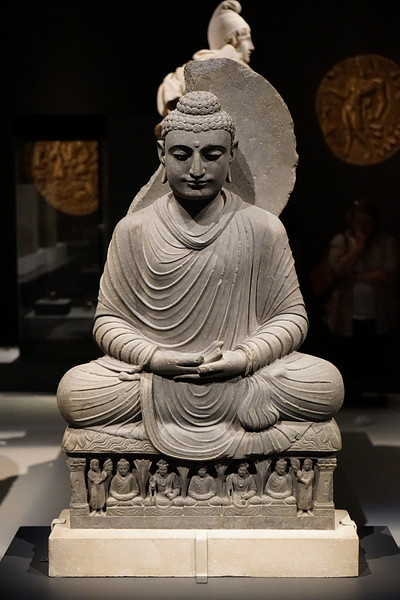
The Four Noble Truths are the foundational tenets of Buddhism, which spark awareness of suffering as the nature of existence, its cause, and how to live without it. The truths are understood as the realization which led to the enlightenment of the Buddha (l. c. 563 - c. 483 BCE) and were the basis of his teachings.
The Four Noble Truths are:
- Life is suffering
- The cause of suffering is craving
- The end of suffering comes with an end to craving
- There is a path which leads one away from craving and suffering
The path alluded to in the fourth truth is The Eightfold Path which serves as both a guide on the road to non-attachment and the road itself. The precepts both inform a traveler on how to proceed and provide the way through spiritual discipline. The eight precepts are:
- Right View
- Right Intention
- Right Speech
- Right Action
- Right Livelihood
- Right Effort
- Right Mindfulness
- Right Concentration
By recognizing the Four Noble Truths and following the Eightfold Path, a person could find release from craving and attachment to the things of the world and liberate oneself from the endless cycle of suffering experienced through rebirth and death. The Truths and the Path are given varying levels of significance by different Buddhist schools in the present day but remain foundational aspects of the faith in all of them.
Buddha’s Enlightenment
According to Buddhist tradition, the Buddha was a Hindu prince named Siddhartha Gautama whose father protected him from witnessing or experiencing any suffering for the first 29 years of his life in order to ward off a prophecy. At Siddhartha’s birth, a seer foretold that if the child witnessed suffering or death, he would become a great spiritual leader. Siddhartha grew up in a kind of pleasure palace, shielded from the outside world, until one day when his coachman (or a substitute for his usual coachman) drove him out of the compound and he encountered the Four Signs:
- An aged man
- A sick man
- A dead man
- An ascetic
After encountering each of the first three, Siddhartha asked the driver, “I, too, am subject to this?” and the coachman told him all who lived would age, experience illness, and eventually die. The realization that he would lose everything he loved, that nothing in life was permanent, tormented him, but then he saw the ascetic smiling serenely from the side of the road. He asked him why he did not seem concerned with life like the people around him were, and the ascetic replied he was pursuing a life of non-attachment and serenity.
At the time he encountered the four signs, Siddhartha was married, heir to his father’s throne, and had a son of his own. After the encounter, however, he could not stop thinking about how everything around him would be lost and so one night he left the palace and his life behind to follow the way of the ascetic.
He first learned meditation and spiritual discipline from various teachers and most likely practiced some form of Jainism, the belief system founded by his older contemporary Mahavira (also known as Vardhamana, l. c. 599-527 BCE) which advocated renunciation of all sense attachments. He fasted to the point of emaciation and embraced every technique suggested by teachers and other ascetics but still had not found the way to live without suffering. Even spiritual discipline carried its own attachments of pride in one’s accomplishments and the joy felt in the company of fellow ascetics and so he went off on his own to sit beneath a Bodhi tree in the village of Bodh Gaya, vowing he would attain enlightenment or die there.
It was while he was meditating beneath the tree that he understood the Four Noble Truths in a flash of illumination. People suffered because they insisted on permanent states of being in a constantly changing world. People defined themselves by their jobs, their family, their possessions and thought of these things as permanent and stable when they could not possibly be because nothing in life was. The craving for permanence in an ever-changing world caused one to suffer and so the end of suffering must necessarily follow from an end to craving. One could end craving, he realized, by redirecting one’s energies and thoughts from unproductive channels, which only increased attachment, craving, and suffering, to productive ones that encouraged non-attachment, serenity, and love both for oneself, others, and the entire illusory world.
This love was not a romantic attachment, it was not even an emotion as usually defined, but a conscious decision to embrace the world as it was, recognize its nature, and allow oneself to feel compassion for all living things by developing a right attitude and behavior conducive to attaining this goal of compassion without attachment. His Eightfold Path developed as a means to this end suggested directly by the Four Noble Truths.
The Four Noble Truths
The Four Noble Truths (in Sanskrit: catvāri āryasatyāni; in Pali: cattāri ariyasaccāni) in the original language are understood to mean "worthy of heeding" and "worthy of respect' but, as scholars Robert E. Buswell, Jr. and Donald S. Lopez, Jr. point out, the worthiness refers to people, not concepts:
Although the term "four noble truths" is well established in English-language works on Buddhism, it is a misleading translation of the original Sanskrit and Pali terms. The term translated as "noble" (ARYA) refers not to the truths themselves but to those who understand them; thus, the compound may more accurately, if less euphoniously, be rendered as "four truths [known by the spiritually] noble"; they are four facts known to be true by those "noble ones" with insight into the nature of reality, but not known by ordinary beings. (304)
The "ordinary beings" referred to are those who insist on the permanence of the world and refuse to recognize that life is constant change. Such people are trapped in the cycle of rebirth and death known as samsara which was driven by what Buddha called the Wheel of Becoming. This concept is defined as a giant, spoked wheel, constantly turning, with ignorance, craving, and aversion at the hub, six states of existence between hub and rim, and the conditions of suffering along the rim. People whose understanding of life is darkened by ignorance, craving, and aversion condemn themselves to spinning round and round on this wheel, dying only to be reborn in the same suffering state eternally.
To break free from the wheel, Buddha said, one needed to recognize the truth of the fundamental interconnectedness of all transient beings which he defined as interdependent arising (Pratītyasamutpāda), the understanding that came to him under the Bodhi tree that allowed him to grasp the Four Noble Truths. Scholar John M. Koller explains:
[Under the Bodhi tree] with passions calmed, mind focused and alert, he reflected on his existence, seeing deeply into the various conditions that had shaped his life. The insight, the meditative knowledge he acquired through this reflection, was that a person’s life is not self-contained and unchanging at its core. Rather, human life is a continuous process of change, rising and falling through interdependence with numerous other processes. This insight into existence as a continuous process of change as a result of interaction with other processes became one of the most important teachings of Buddhism. Known as interdependent arising, this was the key insight of the Buddha’s enlightenment, providing him with a basis for understanding what suffering is, how it arises, and how it can be eliminated. (51)
The difficulty people had, Buddha understood, was in letting go of their insistence on permanent states of being. If one could recognize the principle of interdependent arising, however, one would see that everything one considers unchanging is in a constant state of perpetual change. People are born, grow older, die. Machines age and break down. Money changes hands. Homes age and require repair. The natural world around one provides its own evidence daily of grass growing, birds migrating, trees putting forth leaves.
The operation of the totality of life expressed interdependent arising daily on every level, and, Buddha said, the longer one failed to recognize this, the longer one would suffer. Suffering, then, is a personal choice. One suffers only as much and as long as one chooses to. At any given moment in one’s life, one can choose to stop suffering by recognizing the Four Noble Truths.
Buddha called his path "the middle way" (also "the middle path") in that it lay between complete slavish engagement with the world and total renunciation of it. By following the middle way, one found liberation (nirvana) from the Wheel of Becoming and would no longer be reborn in another life to suffer as one had in all previous lives. The first step on the middle path was acceptance of the first truth.
Truth 1
The first truth is known as duhkha, meaning "suffering". Life is suffering and will remain so as long as one refuses to recognize its true nature. People understood that they suffered, of course, but believed this was an unavoidable aspect of living. Buddha explained that it was not but arose from the skandhas (Sanskrit for "heaps" or "aggregates") which he identified as "the five aggregates of attachment" and further as "the five aggregates of suffering". These are:
- Rūpa – form, material impression
- Vedanā – sensations produced by form, one’s feelings
- Samjñā – perceptions derived from form
- Sańkhāra – psychological activity in response to form
- Vijñāna – one’s consciousness shaped by psychological activity
These five factors encourage attachment to the illusion of permanence of form, not only that one is an unchanging being (that one has a fixed identity) but that everything else is also. Buddha explained the skandhas in action by discussing how they operate:
The Noble Truth of Suffering (duhkha) is this: birth is suffering; aging is suffering; sickness is suffering; death is suffering; sorrow and lamentation, pain, grief, and despair are suffering; association with the unpleasant is suffering; dissociation from the pleasant is suffering; not to get what one wants is suffering – in brief, the five aggregates of attachment are suffering. (Koller, 53)
The skandhas cause suffering by encouraging ignorance of the true nature of life and the self – change – and this ignorance then breeds fear of change because it challenges the illusion of permanence. One craves permanence because it seems to offer safety and comfort, but, since permanence is an illusion, one will never find either and will simply continue craving which leads to suffering.

Truth 2
The second truth is samudaya, meaning "origination", and addresses the cause of suffering. The cause of suffering is the craving for permanence in an impermanent world. Believing one is a permanent entity, one constructs a false world of illusion which, because it is not real, cannot satisfy and leads to continual pain and disappointment. Buddha defines this craving as a passionate desire for things one cannot have:
The Noble truth of the origin of suffering is this: it is this craving (trishna) which produces re-existence and re-becoming, bound up with passionate greed. It finds fresh delight now here and now there, namely, craving for sense-pleasures; craving for existence and becoming; and craving for nonexistence (self-annihilation). (Koller, 56)
In saying that suffering is caused by a craving for existence, Buddha is talking about the truth of existence, not the illusion. People crave actual reality but are bound by illusions they mistake for reality. As long as one continues in ignorance of true reality, one will claim illusion as truth and remain in a state of suffering. People continue to do this, however, because of a fear of loss of identity and selfhood. Believing themselves to be a unique and independent identity, people insist on a reality that supports that, and they reject any challenge to their belief. Koller comments:
If craving for separate and permanent selfhood is the origin of all forms of suffering, what are the origins of this craving? Although there are many conditions, the primary originating condition is ignorance of the true nature of existence as constantly changing and totally interconnected processes. In place of this truth, to which it is blind, ignorance constructs a false reality of separate and permanent selves and things. Mistaking this false reality for the truth, a person takes himself to be a permanent and separate self, separate from other selves and the world of changing processes. The result is to be engulfed in the loneliness and anxiety created by the chasm that separates one’s own existence from the other on all sides. (57)
If one recognizes the true nature of life and eliminates this craving for what cannot be had, one eliminates suffering, as addressed in the third truth.
Truth 3
The third truth is nirodha meaning "cessation". In order to stop craving, one must understand what one is actually craving and recognize that the illusion of permanence cannot satisfy one’s needs. The end of suffering comes with an end to craving when one realizes that what one is craving is true reality, not illusions of reality. Buddha encourages an abrupt stop to the craving behavior along the lines of abandoning a bad habit:
The Noble Truth of the Cessation of Suffering is this: it is the complete cessation of that very craving, giving it up, renouncing it, emancipating oneself from it, detaching oneself from it. (Koller, 57)
It is easy to say one should stop craving, however, and another thing entirely to actually do so. One might recognize that one should stop smoking cigarettes, for example, but put off actually quitting. But in stating the third truth, Buddha is only saying that it is possible to end craving – in the same way a therapist or support group encourages someone to stop smoking by first letting the person know that it can be done. He explains how it can be done in the fourth truth.
Truth 4
The fourth truth is marga, meaning "the path", by which Buddha means his "middle way" in navigating life. He begins by simply stating that there is a path which leads one away from craving and suffering and then explains what that path is:
The Noble Truth of the Path leading to the cessation of suffering is this: It is simply the Noble Eightfold Path, namely, right view; right thought; right speech; right action; right livelihood; right effort; right mindfulness; right concentration. (Koller, 58)
Koller notes how the first three points deal with wisdom, the next two with conduct, the last three with mental discipline but cautions that the path should not be understood as sequential, beginning with point one and ending with point eight, but should be embraced as a totality, all at once. One might need to first work harder at one aspect than another, but all eight points work together to lead one from ignorance toward self-knowledge and enlightenment.
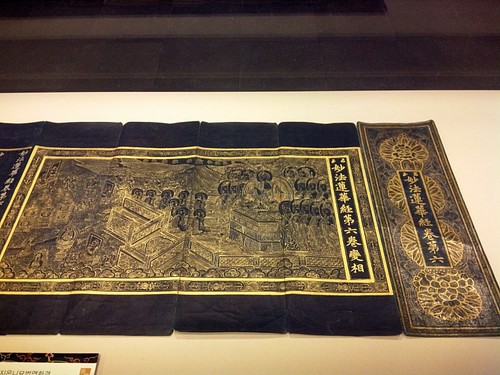
Conclusion
As noted, not all Buddhist schools of thought understand and apply the Four Noble Truths and Eightfold Path in the same way. After the Buddha’s death, his disciples institutionalized his teachings in schools which, fairly quickly (by 383 BCE, at the meeting known as the Second Council) led to disagreements about what his original vision was and the best way it should be lived. The first schism led to the establishment of the Sthaviravada and Mahasanghika schools from which developed many others. The three main schools in the present day are:
- Theravada Buddhism (The School of the Elders)
- Mahayana Buddhism (The Great Vehicle)
- Vajrayana Buddhism (The Way of the Diamond)
All three schools differ from each other (though, technically, Vajrayana is a part of Mahayana) in their interpretation of Buddha’s vision and its application and all three claim to practice the original teachings. One of the main differences between the first two and the last centers on Truth 3 – cessation – in that both Theravada and Mahayana believe one must make the concerted effort to stop craving while Vajrayana believes that one must only recognize the first two truths and craving will end as one pursues lasting values and true reality, leaving illusion and the craving for impossible states of being behind as one embraces non-attachment to a world in which nothing remains the same and clinging to anything can only lead to suffering.
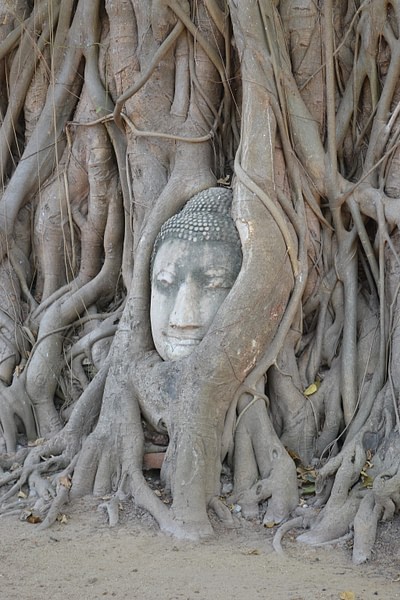




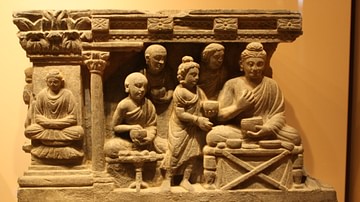
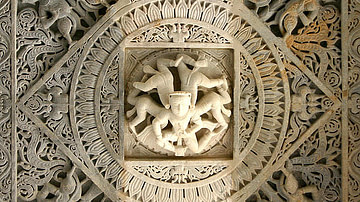
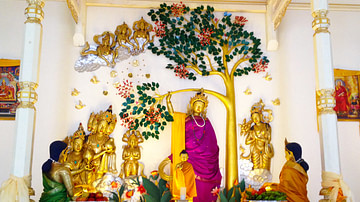
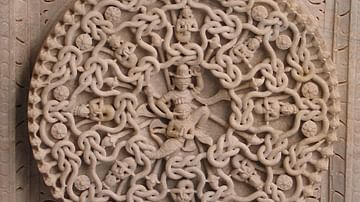
![[An Introduction to Buddhism, Second Edition: Teachings, History and Practices (Introduction to Religion)] [By: Harvey, Peter] [December, 2012]](https://m.media-amazon.com/images/I/51pFMdQZVXL._SL160_.jpg)



